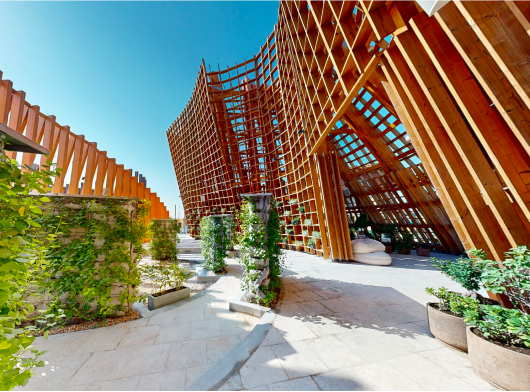
Intelligent plant selection was the subject of the final AIPH Green City Briefing in the 2022/23 series, which presented the AIPH Pavilion at Expo 2023 Doha Qatar as an example of choosing the right plant for the right place for the right reason.
Organised by the International Association of Horticultural Producers (AIPH) in collaboration with the Worshipful Company of Gardeners (WCoG) and sponsor Expo 2023 Doha Qatar, the AIPH Green City Briefings 2022/23 are a series of one-hour webinars focussing on cities around the world that can demonstrate significant progress in including plants and nature in their city’s form and function.
Tim Briercliffe, AIPH Secretary General, led the session and was joined by Sam Lemheney, an event producer who was involved in plant selection for the AIPH Pavilion at Expo 2023 Doha. The Pavilion showcases how plants can be used to transform a space, and encourages visitors to create their own plant-filled living and working spaces.
Qatar has a hot, desert climate that can be challenging for horticulture, but there are many species that are well-adapted to such an environment. Sam commented: “We focused on plants that we knew were heat tolerant and could survive in this environment. They speak to the landscape of Qatar.” These plants were sourced from local nurseries.
“The pavilion is made from wood, so we used plant material to help soften the environment and make it more aesthetically pleasing. Many plants were chosen so for their colour, natural shape, and their drought tolerance, such as Jatropha.”
Other plants included those native to tropical climates not an arid environment, showcasing how intelligently designed structures can meet the needs of plants and people. Sam added: “We could include these tropical plants because they like the heat, as long as we created a local microclimate to suit them and bring the space to life.”
Find out more about the AIPH Pavilion.
Urban environments present their own kind of challenge for plants. How different plants co-exist in these types of urban landscapes was the subject of Dr Mingyu Jiang’s research. As a Teaching Associate in Agriculture, Horticulture and Engineering Sciences at SRUC, Mingyu has investigated the long-term impact of design in urban meadows.
Mingyu explained: “One core problem that has been discovered from both practice and ecology studies is grass dominance.” When planning urban meadows, the design often includes colourful wildflowers. However, after a few years these wildflowers disappear as the grass takes over the landscape. “Wildflower meadow designs are often rejected because people think they are impossible to maintain long-term.”
These issues led Mingyu to develop his research project comparing the co-existence of different species of wildflowers and grasses. His study identified the wildflower species that were better equipped to compete with dominant grasses, such as Achillea millefolium and Echinops sphaerocephalus, and how design could be utilised to provide a solid base for a product that will naturally change over time.
The Briefing session concluded with a discussion that drew greater insights from the speakers about future trends in design and plant preferences.
Watch this Briefing on-demand.